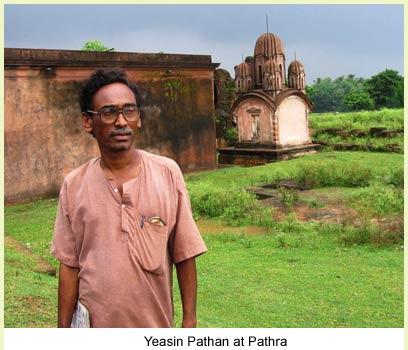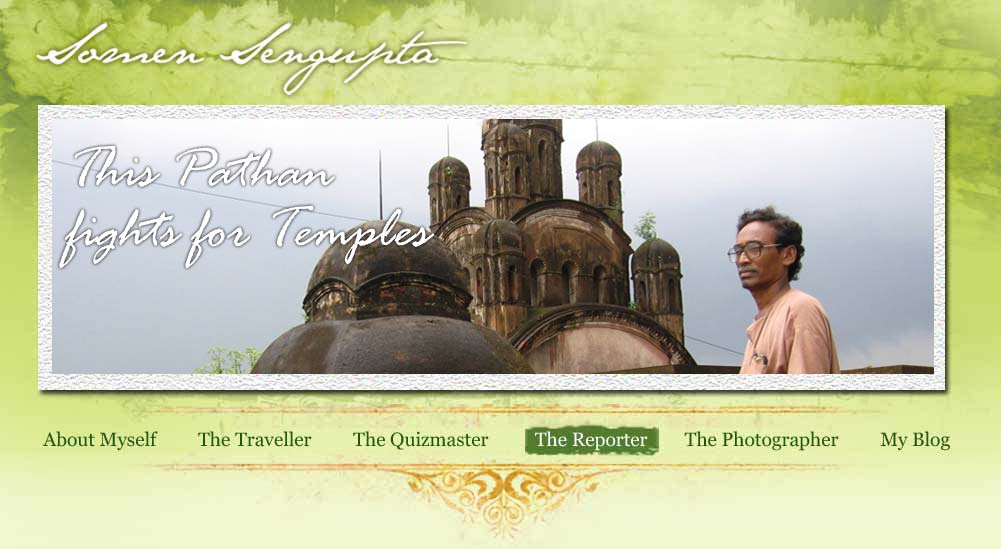This Pathan fights for Temples
The Pioneer – 18th November 2012
In a small village of West Bengal, a poor Muslim has been fighting for the past three decades to save ancient Hindu temples. Somen Sengupta tells us more about him and his lifelong mission
The six-lane express highway from Kolkata suddenly takes a turn at a crossroads near Midnapore town. In a moment, the poverty of rural Bengal comes alive. Narrow and dusty roads welcome you. Small shops are covered with dust on their tin roofs and a number of villagers look at you with curious, enquiring eyes. Welcome to a small, nondescript village called Pathra, which stands like a silent sentinel of time on the bank of Kangshabati river. As you move forward, the road ends at a turning where a yellow building awaits you. At the first glance you will prefer to give it a miss, but once you know the owner of this house, you get excited to meet him. Here Yeasin Pathan, a man in his late 50s with a meagre income o fRs 3,500 per month, lives with six more mouths to feed.
Initially, Pathan fails to cast any impression. His short height and almost lifeless eyes do not give the hint of a noble soul he truly is. Pathan, a Muslim by birth and faith, has been fighting a unique battle for the past 43 years — for the preservation and restoration of more than 30 ancient Hindu temples, for which he has won the President’s gold medal. Pathra is a village with 34 temples and all are more than 200 years old. Not even 10 km from Midnapore town, this village is a gem for those who love history and archaeology, and want to discover the country with a different shade.
Temples here are enriched with terracotta motifs, though some of them are made of stones. Initially, these temples lacked proper care, which along with people’s apathy, saw their steady destruction. By the mid-1970s, all temples in the village were either destroyed or dilapidated. Some of them got submerged in the riverbed.
 History of this region goes back to the Gupta age when it flourished being close to Tamralipta, a major gateway port for Southeast Asia. It was also in the route to Puri from Bengal. From the eighth century to the 12th century, this place was an important hub for Hindus, Jains and Buddhists.
Modern reference of this place is found during the period of Bengal’s nawab, Alivardhi Khan, who appointed a Bidyananda Ghoshal as a revenue collector of Ratnachawk Pargana in 1732. Thus started the new era as Ghoshal went on to establish several temples, most of which were constructed between 1706 and 1771. However, the nawab was not very pleased by all these. Ghoshal was taken to prison and placed under an elephant’s paw. Legend has it that the elephant refused to smash his head. Since it was resurrection under the leg of a beast, the place got a name “Pa-uthra” means “raised from the leg”. It was later distorted to Pathra. History of this region goes back to the Gupta age when it flourished being close to Tamralipta, a major gateway port for Southeast Asia. It was also in the route to Puri from Bengal. From the eighth century to the 12th century, this place was an important hub for Hindus, Jains and Buddhists.
Modern reference of this place is found during the period of Bengal’s nawab, Alivardhi Khan, who appointed a Bidyananda Ghoshal as a revenue collector of Ratnachawk Pargana in 1732. Thus started the new era as Ghoshal went on to establish several temples, most of which were constructed between 1706 and 1771. However, the nawab was not very pleased by all these. Ghoshal was taken to prison and placed under an elephant’s paw. Legend has it that the elephant refused to smash his head. Since it was resurrection under the leg of a beast, the place got a name “Pa-uthra” means “raised from the leg”. It was later distorted to Pathra.
The Ghoshal family changed its family name to Majumdar but its love for temples continued till the end of the 18th century. Meanwhile, another branch of the family, which took the name Bandopadhaya, also started establishing temples. However, the decline began as soon as the two families shifted their base from the village. With no one to look for them, these temples began to lose their lustre, with locals vandalising their priceless artefacts.
Soon, many temples were reduced to rubble. There was neither any initiative from the Government, nor from any academic institution to preserve these monuments. In the mid-1960s, scholars like David J Mccutchin and Tarapada Satra explored the place along with Pathan, then in his youth. It was the time when Pathan’s fascination for these temples emerged and thus began his endeavour to save these temples.
Pathan’s hard work bore fruits when grant came from the Government. Even IIT Kharagpur decided to render technical assistance. As a young boy, Pathan used to visit this village with his father, who had a cattle business. It was the time when he first fell in love with something which was not only odd but also considered sin among the radicals of his co-religionists. Needless to mention, his tryst with Hindu temples was little less than a tumult in the village pre-dominantly populated by Muslims.
The attack came from both sides. Orthodox Hindus found it shocking that a Muslim youth was running from a pillar to post to save temples! In one of Hindu houses, Pathan was not even allowed to touch the document of their family tree as it would make it polluted. His family was totally cornered in his community as well. “I was an outcast and thrown aside by the people of my religion. I was a kafir in their verdict,” says Pathan. “Even the royal family of Majumdar and Bandopadhaya, who built these temples 200 years ago, emerged as one of the biggest obstacles in the mission.”
No one was keen to preserve these sites. And everyone had vested interests. As per Pathan, all pakka (concrete) houses in the villages were constructed from stolen bricks of these temples. Situation became so bad that in late 1970s most temples were either grounded or sank under the riverbed. Pathan still remembers the moment with tears in his eyes. “I went on knocking all doors I knew,” he says. He wrote innumerable letters to authorities, including local politicians, IIT Kharagpur and the President of India. He, however, was marked as a man who was trying to disturb communal harmony of the village.
In December 1982, he was physically abused by local Hindus while he was protesting against the selling of stone slabs from a Durga temple. “I was slapped in public as I took up the issue. My life was a never-ending nightmare,” Pathan recalls. Things changed for good when Pathan decided to organise a Durga Puja for the cause of saving temples. It is perhaps the only puja in Bengal that was organised by a Muslim. “This caught the media attention and I began to get support for my work,” he says. Today 28 out of 34 temples of Pathra are under the supervision of the Archeological Survey of India. They have already repaired 18 temples. All these temples are announced as “monument of national interest”. Also, there is a NGO, ‘Pathra Archeological Preservation Committee, which takes additional care of these temples.It is only the fruit of his hardwork and dedication that today the Archeological Survey of India has granted `4.6 crore to protect these temples.
Most of the temples are inspired by the Bengal school of architecture, with obvious Islamic influences. Stucco lime and sea shell are the main material used. Although most of the terracotta panels have been destroyed or defaced, a handful of them remains visible. Pathan still lives in the same old small house that often gets flooded when the river water overflows. Two years ago he almost went on begging to collect money for his heart treatment. But he remains unconcerned. He is still more worried about more fund and technical knowhow that can ensure complete protection of these temples.
Click here to view the original article
|



